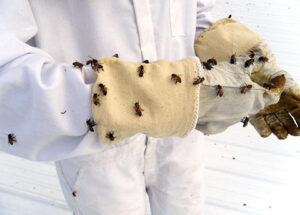I often have the happy privilege of speaking to new-bees. It’s important we all help beginning beekeepers when we can. Their learning curve is steep, yet never has our need to help bees succeed been greater.
To keep key considerations on our collective radar, I’ll post a monthly “to do” list, predominantly for new-bees. If you’re in an environment similar to mine (Southwest Michigan), these are things you should be thinking about for your apiary this time of year.
There are very few black and whites and beekeeping. Thus, this list won’t contain much of what you must be doing, but rather some things to bear in mind, evaluate, and research further to determine what you want to do about them.
1. Figure out what you want in your apiary and where you’re getting it from, including:
- A bee source/supplier. (If you haven’t already lined up a supplier, you may be a little late.)
- The “housing” you’ll use (Langstroth? Top bar? Warre?)
- Frames and foundation if you’re using them. (There are compelling reasons to let bees make their own foundation, but managing that might be a bit much for a newbee; bees sometimes go askew with it and it requires monitoring and course correction.)
- A feeding plan. You might not need to feed bees if the days are warm and sunny when they arrive, but weather is so variable – spring in the Midwest! – that’s why it’s good to have a back-up plan. A package is like a three-pound animal. You can’t park it in an empty box and figure it will fend well by itself during an early May snowstorm. Protect your investment by having a feed plan for dire conditions or to give them a jump-start.
- Your “working bees” equipment (hive tool, smoker, etc.) I have a hive tool with a hook. About twice as much as the cheap ones, but worth it when you figure out the glory of using the hook. Watching a seasoned beekeeper use a hive tool is a worthwhile education in efficiency and minimal equipment impact.
- Your protective wear. My opinion:
- At a minimum I recommend a veil. Stings to the face are never fun.
- Lots of opinions and options on gloves. Until you know what you want to use (or if you even want to use them), dishwashing gloves are an inexpensive way to protect your hands. Bees need something to grab onto to best imbed their stinger (if it comes to that.) Those kinds of gloves are slippery and often they can’t sting thru them. Remember, a bee on your hand doesn’t necessarily mean it’s going to sting you. They’re curious as well.
- I wouldn’t invest in a top-of-the-line protective suit until you know what you want. A cheaper suit won’t hold up season after season, but until you determine if you want a full suit or a half suit and what kind of hood if any, it is a minimal investment. You’ll always need more bee suits for sharing the fun with folks later anyway. Bargain coveralls or light-colored loose pants and a shirt (and duct tape or bands to secure the openings) also work.
2. Get it together.
If you’re painting your hives, you want to make sure they’re thoroughly dried and aired out before your bees arrive. If you’re assembling frames and foundation, caution: this may take more time than you think.
3. Determine where you’ll put your bees.
Is your location legal? Near water? Sunlight? Away from people? When (if?) this snow ever leaves, you’ll need to prepare that spot before your bees arrive. Depending on the type of housing, you may need something to elevate the hive off the ground (ie, cinderblocks, a low table). Is it a spot with a natural windbreak for when winter returns? (Argh.) If not, you can always put one up when the time comes.
4. Find a mentor.
Go to www.northernbeenetwork.com to find one, along with other great resources.
5. Continue learning; beekeeping is a life long, evolving journey.
Search the internet, read books, join a local bee club, and meet people facing similar challenges. I’m always happy to help in any way I can.
I find beekeeping fascinating, educational and yes, sometimes painful, (although the stings were generally caused by my carelessness.) I am excited for all of you beginning this wonderful adventure.

